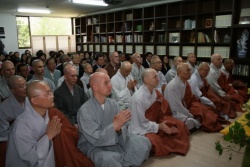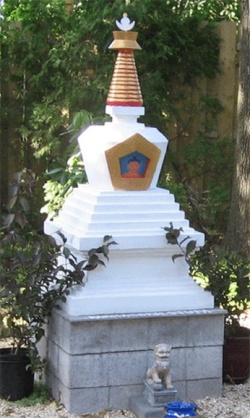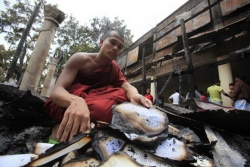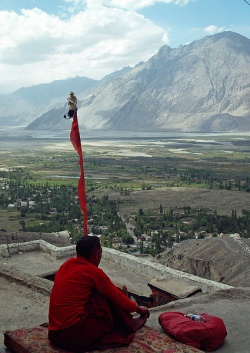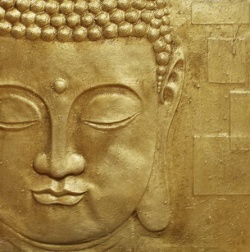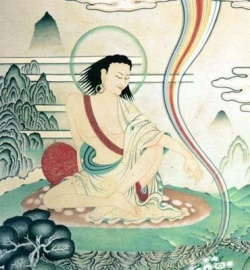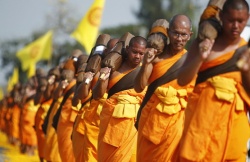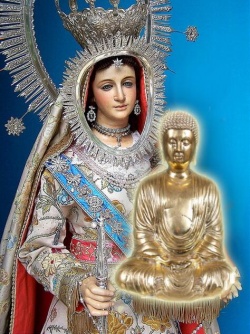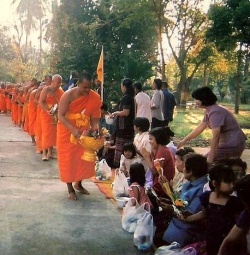Difference between revisions of "Focus on Full Ordination for Buddhist Women"
| Line 168: | Line 168: | ||
However, this [[ordination]] is given by [[gelongs]] and the [[gelongmas]] serve as helpers. | However, this [[ordination]] is given by [[gelongs]] and the [[gelongmas]] serve as helpers. | ||
| − | There is a new [[temple]] outside [[Los Angeles]],[[California]] that is a branch of [[Fo Quan Chan]] in | + | There is a new [[temple]] outside [[Los Angeles]],[[California]] that is a branch of [[Fo Quan Chan]] in [[Taiwan]]. |
Following the International [[Buddhist]] Conference to be held in [[Los Angeles]] rescheduled from July to this coming December, the full dual-ordination will be given by [[gelongs]] and [[gelongmas]]. | Following the International [[Buddhist]] Conference to be held in [[Los Angeles]] rescheduled from July to this coming December, the full dual-ordination will be given by [[gelongs]] and [[gelongmas]]. | ||
| − | Many [[Western]] and [[Tibetan | + | Many [[Western]] and [[Tibetan nuns]] from the [[Tibetan tradition]] have been [[ordained]] in the [[Dharmagupta]]. |
It is [[interesting]] to note that when you are [[ordained]] in this [[tradition]], you do not lose your previous [[tradition]], so in {{Wiki|Los Angeles}} this December, [[nuns]] can wear the [[robes]] of their [[own]] [[tradition]]. | It is [[interesting]] to note that when you are [[ordained]] in this [[tradition]], you do not lose your previous [[tradition]], so in {{Wiki|Los Angeles}} this December, [[nuns]] can wear the [[robes]] of their [[own]] [[tradition]]. | ||
Latest revision as of 12:35, 4 February 2016
When Shakyamuni Buddha laid out the vinaya (code of conduct governing monks and nuns) he also set up the pratimoksha vows (the vows of individual liberation) that precisely define the boundaries of acceptable behavior that is the vinaya.
The vinaya, which is the basis for personal liberation, is available to us today in the Pali, Tibetan, Chinese and Sanskrit languages.
Recognized as being on of the most authentic sources of Buddha’s words, the Pali Vinaya belongs to the Theravada school that is powerful in Thailand, southern India and Sri Lanka and advocates strict adherence to the precepts.
How Buddha Came to Allow Full Ordination for Women
While he was staying in Kapilavastu, Mahaprajapati Gautami (Lord Buddha’s aunt and foster mother) went to see the Blessed One. Grieving over the death of Buddha’s father, she bowed before Buddha and, standing to the side, requested him to allow women to renounce their homes and enter the homeless state under the doctrine and whatever discipline the Blessed One would dictate.
Before this time, women had not been allowed ordination, one of the reasons being that they were recognized as the pillar of the family and it was feared if they were allowed to leave their homes, there would be no more support for the families – the men and children.
For this reason Buddha replied, “Enough, Gautami!” Still, she made this same request three times. Three times the same answer was given. Sadly, Gautami left the Buddha.
Briefly, Gautami and 500 other women (princesses whose husbands had left them behind to take ordination and follow Buddha) followed Buddha and listened to the teachings as renounced persons – wearing robes, with shaved heads.
Ananda, Buddha’s personal attendant, saw the hardships the women endured following the Buddha and went to Buddha and asked why he didn’t ordain them. Can’t women become arhats too?
Buddha said that if he gave ordination to the women the life of the Dharma in this age would be shortened by 500 years or more. Ananda was near Buddha often though and asked many times for the ordination on behalf of the women.
After many requests, Buddha agreed.
“I will give them eight rules.
If they agree to this, then this will be the ordination.”
Ananda went to Gautami and told her what Buddha had said.
She accepted. Buddha then gave the women eight rules.
The Origin of the Eight Rules
While Shakyamuni Buddha was living in the palace of his father the king, he was given everything one could dream of in terms of worldly treasure in order to keep him happy, and so he wouldn’t want to leave. One of the things Buddha was given was a retinue of women.
During this time he saw the women were jealous of each other and vain, and very competitive when serving him.
Buddha felt nuns would need help controlling these tendencies so the eight rules were set up specifically for women.
One vow, for instance, states that any nun, no matter how long she has been ordained, must stand and show respect when any monk enters a room.
About Vows:
The purpose of vows is not to restrain oneself, but rather to set up a clearly defined mandala within which one can practice pure vinaya.
As time passed, Lord Buddha gave a body of advice on the conduct necessary for personal liberation.
This is called the vinaya. Within the vinaya there are sections containing instruction for monks and nuns, the bhikshuni (Skt.)/gelongma (Tib.) Vinaya does not exist as a complete independent unit.
Differences between the Schools and their Presentation of the Vinaya:
Each of the six schools, which formed quite some time after the passing of the Buddha, took this body of advice and divided it up into specific vows, thus leading to the discrepancies with the number of vows a monk or nun would take in each of the traditions.
Tradition Number of Vows for Bhikshunis
Mulasarvastivada 366
Theravada 311
Mahasangika 290
Dharmagupta 348
Sarvastivada 344
Mahisasaka 388
The Mulasarvastivada school is preserved in the Tibetan tradition.
The Mahasangika, Dharmagupta and Mahisasaka schools belong to the Chinese tradition.
The Vows of the Tibetan Tradition
1) Genyen – 5 vows (killing, stealing, lying, sexual misconduct, using intoxicants including tobacco). This is for lay people.
2) Rabjung – The 5 vows and 3 precepts including not wearing ornaments or perfumes, not sitting on high beds or thrones and not eating after midday.
Rabjung means “cutting the crown hair to signify one’s willingness to give up attachment to worldly things and live a homeless life.”
3) Getsul – 36 vows (These 36 vows are the same as the 10 in the Chinese traditions).
Getsul means “the one who’s training in virtuous conduct.”
4) Gelobma – 12 vows including 6 precepts.
The additional vows and precepts concern the behavior of probationary nuns as well as renunciation and morality.
A nun is a gelobma for two years after which time she may take the full ordination of gelongma.
To receive gelobma ordination within the Mulasarvastivada, there must be 12 fully-ordained bhikshunis (including one’s instructor and spiritual mentor) who have been ordained for at least 10 years.
In the Chinese tradition there is no gelobma ordination because the nuns live in a temple and are watched and trained by masters and therefore do not need this probationary time.
Some say that the gelobma/probationary nun ordination was instituted so that, if an aspiring nun is pregnant at the time of ordination, it would not reflect badly on the community.
According to the vinaya, however, as explained by the Ven. Geshe Thubten Ngawang of Hamburg,Germany, Buddha set aside some rules to cover the occasional case of the woman with a child.
In the text it says that women have more difficulties than men, and this ordination prepares the nun to keep the full vows of gelongma ordination.
Geshe-la explained that, in these degenerate times, the more vows a person has, the better their behavior, but to suit the need of our time, the vinaya is adaptable. The five root vows, however, cannot be changed.
Gelongma (Tib.) Bhikshuni (Skt.) – 366 vows
In the Mulasarvastivada, to become gelongma one should have successfully competed the two-year probationary period and reached the age of 20 years.
In the morning of the ordination the gelobma should receive the full ordination from 12 gelongmas who have been ordained at least 10 years, a preceptor, and common master (the gelongma who is head of the community) and then, in the afternoon, from 10 gelongs who have been ordained at least 10 years.
In areas outside large monastic communities, four gelongs and six gelongmas may be substituted or, if one lives very far away in an area where travel is dangerous, the gelongmas may send messengers in their place.
During the ordination by gelongmas, the preceptor (a gelongma who takes care of the gelobma during the two-year period) should have received permission from the other gelongmas in the community for the ordination.
A probationary nun without a preceptor may not receive full ordination.
Although the vinaya for all schools clearly states that full ordination must be given by both gelongmas and gelongs, so far, in Taiwan and Hong Kong, monks give the ordination more often than nuns.
Why There Are No Gelongmas in the Tibetan Tradition
According to historical religious texts, the Mulasarvastivada Vinaya and gelong ordination was established in 8th century Tibet during the reign of King Trisong Detsen by the great Abbot Shantarakshita.
There are no references to gelongma ordination at this time, but texts found in the 12th century indicated that, after the abbot’s death, Dharma declined in Tibet, but Lachen-gongpa Rabsel (832-915) restored the lineage of the ordination during his lifetime.
Another indication that the ordination was still intact at this time is found in a prayer written by the great translator Nagtso to Lord Atisha in which he talks about the “four kinds of discipline:”
During the period 1456-1539, writings show that the very learned Kagyü master, Karma Trinley, asked Pema Karpo, who was writing a book about the ritual of the bhikshuni ordination, if the ordination truly existed in Tibet.
Pema Karpo replied saying there were many texts dealing with the subject like Vinaya Aghama, Karma Shatam and Karma Vakya.
So, although the bhikshuni ordination existed on paper, there were no bhikshunis inTibet.
According to the Theravada, because here are no bhikshunis in Tibet with the necessary credentials, there can be no bhikshuni ordination.
What Should a Woman Do If She Wants to Be a Gelongma?
One can go to Taiwan or Hong Kong and take ordination in the Chinese tradition where, after a few weeks of training, one takes the three sets of vows: novice, bodhisattva and fully-ordained one.
However, this ordination is given by gelongs and the gelongmas serve as helpers.
There is a new temple outside Los Angeles,California that is a branch of Fo Quan Chan in Taiwan.
Following the International Buddhist Conference to be held in Los Angeles rescheduled from July to this coming December, the full dual-ordination will be given by gelongs and gelongmas.
Many Western and Tibetan nuns from the Tibetan tradition have been ordained in the Dharmagupta.
It is interesting to note that when you are ordained in this tradition, you do not lose your previous tradition, so in Los Angeles this December, nuns can wear the robes of their own tradition.
Because it is a dual-ordination, these gelongmas will be able to participate in gelongma ordinations after holding the vows for 10 years.
Through this new ordination, it is hoped that a sound bhikshuni lineage will be established and passed on for the benefit of all sentient beings in order to keep the precious teachings of Lord Buddha for many eons to come.
Information for the above article was taken from many sources including: Life of Buddha by A.E. Thomas; Bhikshuni Ordination by Chatsuraman Kabilsing; and Women in Primitive Buddhism by L.B. Horner.
